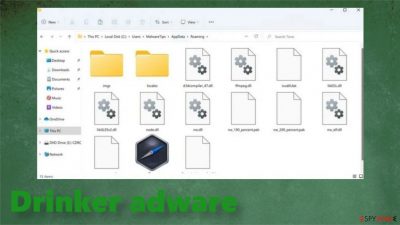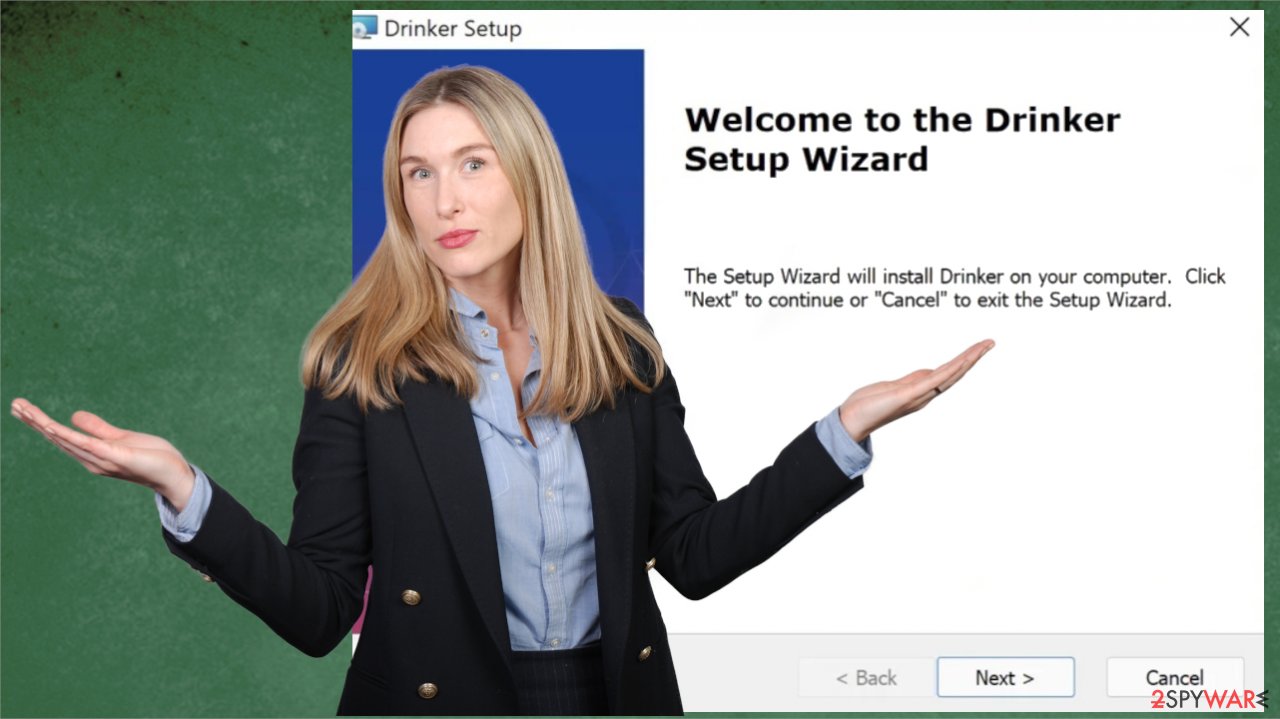Drinker adware (spam)
Drinker adware Removal Guide
What is Drinker adware?
Drinker adware is the rogue application that exposes users to dubious webpages

Drinker adware is the program that is promoted as the application allowing users to set notifications when to drink water. This tool should show reminders and help people to drink more water, but it is a typical advertising-supported software that delivers fake promotions to other tools and advertisements pushing questionable applications and services.
A potentially unwanted program like this is capable of replacing various graphical content on sites with related advertisements and changing website interfaces. These ads push online scams and endorse other tools resembling the Drinker adware and other useless tools.
The intrusive application promotes applications from other developers and lets scammers abuse product affiliate programs and obtains payments from the view and page visit revenue that apps like Drinker adware generates. These apps can also collect information related to the users' habits online. Users are always warned by experts[1] about this.
Overview of the PUP
Drinker virus is a program that delivers advertisements and affects the performance significantly because it triggers redirects when the browser is closed, so the users are exposed to various commercial content all the time. These advertisements are intrusive and can show scamming material, fake alerts, and warnings, to abuse social engineering methods.[2]
| Name | Drinker |
|---|---|
| Type | Adware, redirect |
| Category | Potentially unwanted program |
| Symptoms | Deceptive ads not originating from the site, intrusive pop-ups, affected speed and performance of the machine |
| Functionality | It supposed to set reminders for water drinking |
| Distribution | Freeware installations, other misleading programs, promotional sites |
| Removal | These intruders can be removed faith AV tools that detect[3] files as possibly malicious |
| Eliminations | Run FortectIntego to clear virus damage properly |
Drinker PUP can be installed on purpose, but mostly the application appears out of nowhere because it is repacked with freeware programs or installed when a shady page gets visited. These programs can run in the background of the machine and cause other issues related to redirects and visits to particular websites.
Drinker adware can be promoted as a useful tool and claim that there is a lot of value in having the program installed on the computer or mobile phone, so users install the bad application without thinking too much about red flags. However, any installations happening via random ads can result in malware installs instead.
This shady application might not show itself on the machine but cause all the advertising pop-ups and redirects. Also, these commercial content redirects and applications like the Ads by Drinker intruder can track data about users and their habits online. Those details are needed for third-party advertisers and their advertising campaigns later on.

Remove the intrusive application
Drinker adware can be stopped and should be removed properly to stop the unwanted behavior on the machine. How do achieve the best results and terminate the application that triggers issues with the machine? Run anti-malware tools and check the system fully, so all of the problems created by the PUP are no longer bothering you.
This intruder can trigger the installation of other programs, so removing the Drinker PUP as soon as possible avoids further damage. Try tools like Malwarebytes or SpyHunter 5Combo Cleaner and run the full system scan that the program performs. These security tools check all parts of the machine, so you can remove the infection quickly.
Remove the program using trustworthy tools, and your device will perform better than before. Make sure to choose a reliable source for those tools when you terminate the Drinker adware. You can also try to remove the infection by yourself. it can be done by uninstalling unwanted applications or even resetting browsers fully to default.
Instructions for Windows 10/8 machines:
- Enter Control Panel into Windows search box and hit Enter or click on the search result.
- Under Programs, select Uninstall a program.
![Uninstall from Windows 1 Uninstall from Windows 1]()
- From the list, find the entry of the suspicious program.
- Right-click on the application and select Uninstall.
- If User Account Control shows up, click Yes.
- Wait till uninstallation process is complete and click OK.
![Uninstall from Windows 2 Uninstall from Windows 2]()
If you are Windows 7/XP user, proceed with the following instructions:
- Click on Windows Start > Control Panel located on the right pane (if you are Windows XP user, click on Add/Remove Programs).
- In Control Panel, select Programs > Uninstall a program.
![Uninstall from Windows 7/XP Uninstall from Windows 7/XP]()
- Pick the unwanted application by clicking on it once.
- At the top, click Uninstall/Change.
- In the confirmation prompt, pick Yes.
- Click OK once the removal process is finished.
These applications can interfere with the web browser settings and install tools on the browsing app directly. You should take care of that and try to remove the Drinker adware fully from the machine. You might also need to clear browsers and installed programs there, so rely on the guide or the full-on reset of the program.
You may remove virus damage with a help of FortectIntego. SpyHunter 5Combo Cleaner and Malwarebytes are recommended to detect potentially unwanted programs and viruses with all their files and registry entries that are related to them.
Getting rid of Drinker adware. Follow these steps
Remove from Microsoft Edge
Delete unwanted extensions from MS Edge:
- Select Menu (three horizontal dots at the top-right of the browser window) and pick Extensions.
- From the list, pick the extension and click on the Gear icon.
- Click on Uninstall at the bottom.

Clear cookies and other browser data:
- Click on the Menu (three horizontal dots at the top-right of the browser window) and select Privacy & security.
- Under Clear browsing data, pick Choose what to clear.
- Select everything (apart from passwords, although you might want to include Media licenses as well, if applicable) and click on Clear.

Restore new tab and homepage settings:
- Click the menu icon and choose Settings.
- Then find On startup section.
- Click Disable if you found any suspicious domain.
Reset MS Edge if the above steps did not work:
- Press on Ctrl + Shift + Esc to open Task Manager.
- Click on More details arrow at the bottom of the window.
- Select Details tab.
- Now scroll down and locate every entry with Microsoft Edge name in it. Right-click on each of them and select End Task to stop MS Edge from running.

If this solution failed to help you, you need to use an advanced Edge reset method. Note that you need to backup your data before proceeding.
- Find the following folder on your computer: C:\\Users\\%username%\\AppData\\Local\\Packages\\Microsoft.MicrosoftEdge_8wekyb3d8bbwe.
- Press Ctrl + A on your keyboard to select all folders.
- Right-click on them and pick Delete

- Now right-click on the Start button and pick Windows PowerShell (Admin).
- When the new window opens, copy and paste the following command, and then press Enter:
Get-AppXPackage -AllUsers -Name Microsoft.MicrosoftEdge | Foreach {Add-AppxPackage -DisableDevelopmentMode -Register “$($_.InstallLocation)\\AppXManifest.xml” -Verbose

Instructions for Chromium-based Edge
Delete extensions from MS Edge (Chromium):
- Open Edge and click select Settings > Extensions.
- Delete unwanted extensions by clicking Remove.

Clear cache and site data:
- Click on Menu and go to Settings.
- Select Privacy, search and services.
- Under Clear browsing data, pick Choose what to clear.
- Under Time range, pick All time.
- Select Clear now.

Reset Chromium-based MS Edge:
- Click on Menu and select Settings.
- On the left side, pick Reset settings.
- Select Restore settings to their default values.
- Confirm with Reset.

Remove from Mozilla Firefox (FF)
Remove dangerous extensions:
- Open Mozilla Firefox browser and click on the Menu (three horizontal lines at the top-right of the window).
- Select Add-ons.
- In here, select unwanted plugin and click Remove.

Reset the homepage:
- Click three horizontal lines at the top right corner to open the menu.
- Choose Options.
- Under Home options, enter your preferred site that will open every time you newly open the Mozilla Firefox.
Clear cookies and site data:
- Click Menu and pick Settings.
- Go to Privacy & Security section.
- Scroll down to locate Cookies and Site Data.
- Click on Clear Data…
- Select Cookies and Site Data, as well as Cached Web Content and press Clear.

Reset Mozilla Firefox
If clearing the browser as explained above did not help, reset Mozilla Firefox:
- Open Mozilla Firefox browser and click the Menu.
- Go to Help and then choose Troubleshooting Information.

- Under Give Firefox a tune up section, click on Refresh Firefox…
- Once the pop-up shows up, confirm the action by pressing on Refresh Firefox.

Remove from Google Chrome
Delete malicious extensions from Google Chrome:
- Open Google Chrome, click on the Menu (three vertical dots at the top-right corner) and select More tools > Extensions.
- In the newly opened window, you will see all the installed extensions. Uninstall all the suspicious plugins that might be related to the unwanted program by clicking Remove.

Clear cache and web data from Chrome:
- Click on Menu and pick Settings.
- Under Privacy and security, select Clear browsing data.
- Select Browsing history, Cookies and other site data, as well as Cached images and files.
- Click Clear data.

Change your homepage:
- Click menu and choose Settings.
- Look for a suspicious site in the On startup section.
- Click on Open a specific or set of pages and click on three dots to find the Remove option.
Reset Google Chrome:
If the previous methods did not help you, reset Google Chrome to eliminate all the unwanted components:
- Click on Menu and select Settings.
- In the Settings, scroll down and click Advanced.
- Scroll down and locate Reset and clean up section.
- Now click Restore settings to their original defaults.
- Confirm with Reset settings.

Delete from Safari
Remove unwanted extensions from Safari:
- Click Safari > Preferences…
- In the new window, pick Extensions.
- Select the unwanted extension and select Uninstall.

Clear cookies and other website data from Safari:
- Click Safari > Clear History…
- From the drop-down menu under Clear, pick all history.
- Confirm with Clear History.

Reset Safari if the above-mentioned steps did not help you:
- Click Safari > Preferences…
- Go to Advanced tab.
- Tick the Show Develop menu in menu bar.
- From the menu bar, click Develop, and then select Empty Caches.

After uninstalling this potentially unwanted program (PUP) and fixing each of your web browsers, we recommend you to scan your PC system with a reputable anti-spyware. This will help you to get rid of Drinker registry traces and will also identify related parasites or possible malware infections on your computer. For that you can use our top-rated malware remover: FortectIntego, SpyHunter 5Combo Cleaner or Malwarebytes.
How to prevent from getting adware
Do not let government spy on you
The government has many issues in regards to tracking users' data and spying on citizens, so you should take this into consideration and learn more about shady information gathering practices. Avoid any unwanted government tracking or spying by going totally anonymous on the internet.
You can choose a different location when you go online and access any material you want without particular content restrictions. You can easily enjoy internet connection without any risks of being hacked by using Private Internet Access VPN.
Control the information that can be accessed by government any other unwanted party and surf online without being spied on. Even if you are not involved in illegal activities or trust your selection of services, platforms, be suspicious for your own security and take precautionary measures by using the VPN service.
Backup files for the later use, in case of the malware attack
Computer users can suffer from data losses due to cyber infections or their own faulty doings. Ransomware can encrypt and hold files hostage, while unforeseen power cuts might cause a loss of important documents. If you have proper up-to-date backups, you can easily recover after such an incident and get back to work. It is also equally important to update backups on a regular basis so that the newest information remains intact – you can set this process to be performed automatically.
When you have the previous version of every important document or project you can avoid frustration and breakdowns. It comes in handy when malware strikes out of nowhere. Use Data Recovery Pro for the data restoration process.
- ^ Lesvirus. Lesvirus. Virus removal guides.
- ^ Social engineering. Wikipedia. The free encyclopedia.
- ^ Detection rate. VirusTotal. Online malware scanner.





















